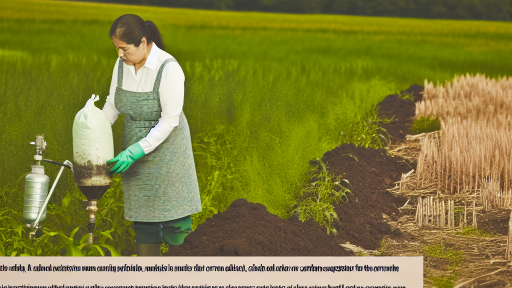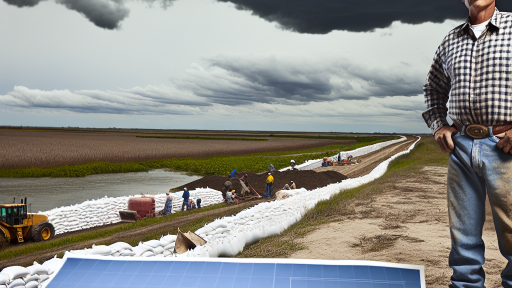Understanding Climate Resilience
Definition of Climate Resilience
Climate resilience refers to the ability of farms to adapt to climate change impacts.
It involves implementing strategies that reduce vulnerability to extreme weather events.
Resilient farms can recover from disruptions more quickly than non-resilient ones.
Importance of Climate Resilience in Agriculture
Farming plays a critical role in food security and economic stability.
However, climate change threatens these vital functions.
Farmers face increasing instances of droughts, floods, and unpredictable weather patterns.
Such changes can drastically affect crop yields and farm income.
Benefits of Building Climate Resilience
Building climate resilience offers numerous advantages for farmers and communities.
- Enhanced productivity by safeguarding crops and livestock.
- Reduced economic losses through effective risk management strategies.
- Improved soil health, which supports sustainable farming practices.
Trends in Climate Resilient Farming Practices
Innovative practices are emerging to promote climate resilience in agriculture.
For instance, agroforestry integrates trees within farming systems.
This method helps improve biodiversity and soil fertility.
Additionally, implementing crop rotation can enhance soil health and reduce pest outbreaks.
How Farmers Can Prepare for Climate Change
Farmers can take proactive steps to increase their resilience to climate impacts.
Investing in stress-resistant crop varieties is essential for coping with drought and extreme weather.
Water management techniques, such as rainwater harvesting, are also beneficial.
Transform Your Agribusiness
Unlock your farm's potential with expert advice tailored to your needs. Get actionable steps that drive real results.
Get StartedFarmers should consider diversifying their income sources to reduce reliance on single crops.
Financial Risk Assessment
Identifying Vulnerabilities in Agricultural Operations
Assessing financial risk is crucial for climate-resilient farming.
Farmers need to understand their vulnerabilities to external pressures.
Start by evaluating the impact of climate change on yields.
Climate events such as droughts and floods significantly affect production.
Next, analyze the financial implications of those risks.
This includes increased costs for water and crop irrigation.
Additionally, consider the potential loss of income during adverse conditions.
Understanding fixed versus variable costs helps as well.
Fixed costs remain constant, regardless of production levels.
Variable costs change with the level of output and can be managed.
Furthermore, examine the strengths and weaknesses of existing resources.
Evaluate soil health and water availability as key factors.
Regular soil testing can highlight nutrient deficiencies.
Considering diversification in crops can also mitigate risk.
Identify which crops perform well under fluctuating conditions.
Utilizing Financial Tools
Various financial tools can help manage agricultural risks effectively.
Insurance can protect against crop failures due to extreme weather.
Farmers should explore government-backed programs as well.
Diverse funding sources can provide financial stability.
Grants and loans specifically for sustainable practices warrant investigation.
Finally, ensure proper record-keeping for all financial transactions.
This will facilitate better analysis and forecasting of potential risks.
Tracking expenses and revenues helps identify trends over time.
Showcase Your Farming Business
Publish your professional farming services profile on our blog for a one-time fee of $200 and reach a dedicated audience of farmers and agribusiness owners.
Publish Your ProfileUltimately, understanding financial vulnerabilities empowers farmers.
It allows for strategic planning to enhance resilience against climate impacts.
Diversifying Income Streams
Exploring Alternative Revenue Models for Farmers
Diversifying income streams is essential for modern farmers.
This strategy enhances resilience against climate impacts.
Furthermore, it reduces reliance on a single crop or market.
Agro-Tourism Opportunities
Agro-tourism can provide additional revenue for farmers.
It attracts visitors to experience farm life directly.
Farmers can host events, tours, or workshops to engage the community.
Such activities promote local agriculture and educate the public.
Value-Added Products
Creating value-added products can significantly increase profits.
Farmers can process crops into jams, cheeses, or baked goods.
This approach appeals to consumers seeking unique products.
Additionally, it helps in extending the shelf life of products.
Renewable Energy Initiatives
Investing in renewable energy can be a profitable venture for farmers.
Solar panels or wind turbines can power farm operations.
Excess energy can be sold back to the grid for income.
These initiatives also promote sustainability and reduce costs.
Partnerships and Collaborations
Forming partnerships with local businesses can create new income streams.
Farmers can collaborate on community-supported agriculture programs.
This connection fosters strong local food systems.
It also encourages consumers to buy directly from farms.
Diversifying Crops and Livestock
Diverse cropping and livestock systems enhance farm resilience.
These systems improve soil health and reduce pest issues.
Moreover, they allow farmers to tap into different markets.
Implementing crop rotations can boost productivity over time.
Utilizing Technology for Efficient Operations
Farmers can leverage technology to optimize operations.
Precision agriculture tools enhance resource management.
Data analysis aids in predicting market trends and crop yields.
These technologies also contribute to better decision-making.
Creating Online Marketplaces
Establishing online platforms helps farmers reach broader audiences.
Through e-commerce, they can sell products directly to consumers.
This method can also reduce transportation costs and waste.
It enables farmers to showcase their brands effectively.
Explore Further: Eco-Friendly Pest Control for Climate-Smart Farming
Investing in Sustainable Technologies
Importance of Sustainable Farming Tools
Sustainable farming tools play a crucial role in enhancing farm resilience.
They help reduce dependence on fossil fuels and harmful chemicals.
Moreover, these tools promote biodiversity and soil health.
Types of Eco-Friendly Farming Tools
Farmers can choose from various eco-friendly technologies.
Examples include solar-powered irrigation systems and bio-based fertilizers.
Additionally, precision agriculture technologies have gained popularity.
Showcase Your Farming Business
Publish your professional farming services profile on our blog for a one-time fee of $200 and reach a dedicated audience of farmers and agribusiness owners.
Publish Your ProfileThese tools help optimize inputs and reduce waste.
Cost-Benefit Analysis
Next, we will explore the cost-benefit analysis of these technologies.
Investing in sustainable equipment often leads to long-term savings.
For example, initial costs may be higher, but maintenance remains low.
Furthermore, these tools can increase crop yields over time.
Assessing Initial Investment
Farmers should evaluate the upfront costs of sustainable technologies.
Grants and subsidies often help offset these initial investments.
Additionally, local agricultural cooperatives may offer financial assistance.
Understanding Long-Term Benefits
Long-term benefits extend beyond financial gains.
Adopting eco-friendly tools enhances farm resilience against climate change.
These investments also improve soil health and reduce erosion.
Case Studies of Successful Implementations
Several farms showcase the advantages of sustainable technologies.
For instance, Green Acres Farm saw a 30% reduction in water usage.
This change resulted from switching to a solar-powered irrigation system.
Similarly, Happy Harvest Farms experienced increased crop yields by 20%.
This improvement derived from using precision agriculture tools.
Implications of Sustainable Technology Investments
Investing in sustainable technologies proves beneficial for farmers.
Such investments lead to cost savings and environmental resilience.
Ultimately, eco-friendly farming tools represent a win-win scenario.
Find Out More: Enhancing Energy Efficiency in Agricultural Operations
Government Grants and Subsidies
Navigating Financial Support for Climate-Resilient Initiatives
Government grants and subsidies offer critical support for climate-resilient farming practices.
These financial resources help farmers invest in sustainable technologies.
Moreover, they encourage the adoption of eco-friendly farming methods.
Farmers can benefit significantly from targeted funding opportunities.
Understanding the available financial options is essential for farmers.
Types of Grants and Subsidies
Various types of grants and subsidies exist to support farmers.
Federal, state, and local programs provide different funding sources.
For instance, the USDA offers grants for conservation practices.
In addition, some states have specific programs focused on climate resilience.
Farmers should research multiple avenues to maximize funding.
Eligibility Criteria
Eligibility criteria for grants and subsidies can vary widely.
Most programs require specific project proposals showcasing climate resilience.
Farmers may need to demonstrate sustainable practices to qualify.
Additionally, certain income thresholds may apply based on farm revenue.
It’s crucial for farmers to thoroughly read the eligibility guidelines.
Application Process
The application process can seem daunting for many farmers.
However, a well-prepared application increases the chances of approval.
First, farmers should collect all necessary documentation promptly.
This might include financial records and project plans.
Additionally, seeking assistance from agricultural consultants can be beneficial.
Showcase Your Farming Business
Publish your professional farming services profile on our blog for a one-time fee of $200 and reach a dedicated audience of farmers and agribusiness owners.
Publish Your ProfileStaying Informed about Changes
Grant programs frequently change their requirements and funding levels.
Farmers must stay informed to take advantage of new opportunities.
Regularly checking government websites can provide updates.
Furthermore, engaging with local agricultural extension offices is valuable.
Networking with other farmers can also yield useful information.
Examples of Successful Initiatives
Many farms have successfully implemented climate-resilient practices.
For example, Maria’s Organic Farm received a USDA grant for water conservation systems.
This funding allowed her to invest in rainwater harvesting technology.
Similarly, Green Valley Farm utilized subsidies for soil health improvement techniques.
These examples demonstrate the potential of financial support for sustainability.
You Might Also Like: Maximizing Farm Profitability Amid Climate Change Challenges

Implementing Crop Insurance: Protecting against Extreme Weather Events
Importance of Crop Insurance
Crop insurance provides vital financial protection for farmers.
It safeguards against losses caused by natural disasters.
In recent years, extreme weather events have increased unpredictably.
Farmers face significant risks without proper insurance coverage.
Thus, crop insurance becomes an essential component of farming strategy.
Types of Crop Insurance Coverage
Farmers can choose from various types of crop insurance policies.
Actual Production History (APH) insurance covers yield loss.
Revenue Protection (RP) insurance guarantees income based on yield and market prices.
Index-based insurance pays based on specific triggers, such as rainfall levels.
Farmers should evaluate their specific needs to select the right option.
Evaluating Risks and Selecting Policies
Farmers must assess their vulnerability to specific weather risks.
Region, crop type, and historical data are key factors in this evaluation.
Consulting with an insurance agent can provide valuable insights.
The agent can help determine the appropriate coverage and limit needed.
Moreover, farmers should regularly review their policies each year.
Government Programs and Subsidies
The government offers various programs to support crop insurance.
The Federal Crop Insurance Corporation helps subsidize premium costs.
Additionally, the USDA provides resources to navigate insurance options.
Farmers should utilize these resources to ensure adequate coverage.
This financial assistance helps maintain farm viability in tough times.
Long-Term Benefits of Crop Insurance
Implementing crop insurance leads to long-term farm stability.
It allows farmers to recover more quickly after extreme weather events.
Additionally, insurance can enhance lenders’ confidence in providing loans.
Access to credit enables farmers to invest in future growth.
Consequently, crop insurance plays a vital role in fostering resilience.
Explore Further: How Farmers Can Thrive Despite Climate Challenges
Creating a Financial Plan
Budgeting for Climate Change
Effective budgeting is essential for climate-resilient farming.
Farmers must analyze their current expenses and forecast future costs.
Consider variable expenses like seeds, fertilizers, and labor.
Showcase Your Farming Business
Publish your professional farming services profile on our blog for a one-time fee of $200 and reach a dedicated audience of farmers and agribusiness owners.
Publish Your ProfileAdditionally, account for potential increases in extreme weather events.
Prepare for unexpected costs by setting aside contingency funds.
Forecasting Revenue Streams
Identifying potential revenue sources is vital for farm sustainability.
Diversify crops to minimize the risk of complete loss.
Invest in value-added products, such as jams or cheeses, to increase income.
Explore market trends to better anticipate consumer demand.
Utilizing climate data can also inform timely decisions and production forecasts.
Investing in Resilience
Investing in climate resilience can protect long-term farm viability.
Consider techniques like agroforestry, which enhances productivity and biodiversity.
Implement water conservation systems such as rainwater harvesting.
Soil health investments, like cover cropping, can improve yields and sustainability.
Evaluate grants or funding opportunities dedicated to climate adaptation.
Utilizing Technology
Modern technology can optimize farm financial management.
Utilize software for tracking expenses and projecting financial needs.
Invest in precision agriculture tools to increase efficiency and reduce waste.
Market analytics platforms can provide insights into pricing and demand.
These technologies help farmers make informed financial decisions.
Collaborative Financial Strategies
Networking with other farmers can enhance financial planning efforts.
Join local and regional farming cooperatives for shared resources.
Consider collective purchasing agreements to lower costs on inputs.
Additionally, collaborating on marketing can improve product visibility.
Leverage community support for funding opportunities and knowledge sharing.
Reviewing and Adjusting Plans
Routine review and adjustment of financial plans are crucial.
Set specific intervals for evaluating financial status and objectives.
Adapt to changing climate conditions by reassessing budgets and forecasts.
Adjust strategies based on the latest agricultural research and technological advancements.
Continuous improvement ensures resilience amidst climate challenges.
Building Community Partnerships
Collaborating for Shared Resources
Building community partnerships enhances resilience in farming.
Farmers can share resources to improve efficiency and reduce costs.
This collaboration allows access to equipment and knowledge.
For instance, a group of nearby farmers can invest in a communal tractor.
This arrangement minimizes individual expenses significantly.
Pooling Risks and Benefits
Partnerships can also help mitigate risks associated with climate change.
By pooling assets, farmers can protect against potential losses.
For example, if one farmer faces a crop failure, others can support them.
This solidarity fosters a sense of community resilience.
Creating Support Networks
Establishing support networks among farmers strengthens bonds.
Farmers can share information about best practices and innovations.
Regular meetings can facilitate knowledge exchange and strategy development.
Such networks may also extend to local businesses and organizations.
Showcase Your Farming Business
Publish your professional farming services profile on our blog for a one-time fee of $200 and reach a dedicated audience of farmers and agribusiness owners.
Publish Your ProfileLeveraging Community Resources
Communities often have resources available for farmers.
Local extension services can provide expertise in climate-resilient practices.
Farmers can tap into these resources for better education and training.
Furthermore, collaborations can lead to funding opportunities.
Grants and local government support may become more accessible.
Success Stories and Case Studies
Sharing success stories from collaborative efforts can inspire others.
For instance, the Evergreen Farmers’ Coalition reduced costs significantly.
By pooling resources, they increased their sustainability efforts effectively.
Such examples prove that working together yields tangible results.
Additional Resources
Climate-Smart Agriculture and Forestry Resources | Farmers.gov
N.C. A&T, Environmental Defense Fund partner on farming study …




